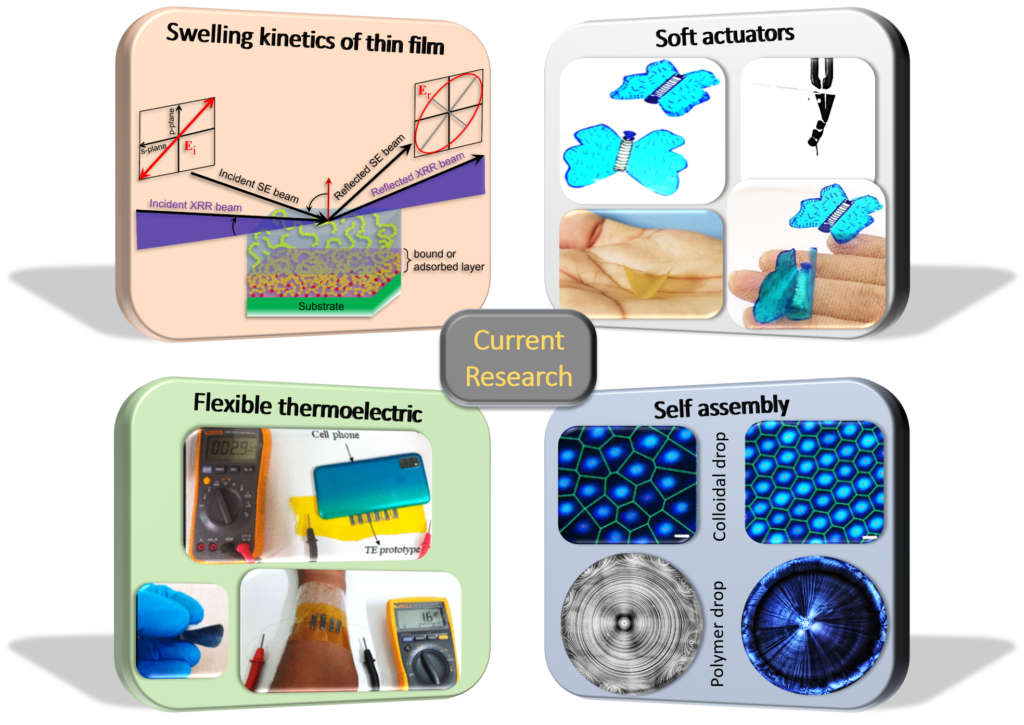
Overview
At Soft Materials Lab, we work with polymers and colloids. We study the actuation behavior of soft polymeric actuators in response to various stimuli, particularly water vapor, for potential applications in the field of soft robotics. Diving deeper we probe the various polymer kinetics using spectroscopic ellipsometry and X-ray reflectivity. In addition we investigate the self assembly of colloidal particles and also work with flexible thermoelectrics for energy generation.
Swelling kinetics of polymer films
Polymer thin films are essential in various applications, including coatings, electronic devices, sensors, and biomedical devices, due to their unique properties arising from their confined dimensions. Accurate characterization of these films requires sensitive techniques like Spectroscopic Ellipsometry (SE). However, one struggles during SE analysis while simultaneously determining film thickness and refractive indices, particularly in ultrathin films with thicknesses just a few tens of nanometers. These challenges are more pronounced in optically anisotropic polymer films, primarily due to strong statistical correlations between fit parameters involved in the SE model. To address this, we developed an approach that allows for more accurate determination of both thickness and refractive indices, validated through SE measurements on thin films of hydrophobic and hydrophilic nature. Additionally, these polymer thin films often feature a bound layer or an adsorbed layer at the polymer/substrate interface, whose characteristics have long been of interest because of its effect on overall thin film properties. Although, direct investigations are challenging as the layer is buried deep within the thin film. Addressing this, our work introduces a novel method to probe the bound layer in hydrophilic polymer films by analyzing swelling kinetics across various thicknesses. This method effectively estimates the thickness and density of the bound layer without the risks associated with traditional solvent rinsing method, known by Guiselin’s approach. Interestingly, annealing has effect on both the bound layer, and the adsorbed layer determined using Guiselin’s approach. New insights get revealed when comparing these two layers, showing inherent structural differences close to the interfaces. For instance, the adsorbed layer, unlike the bound layer, swells upon exposure to water vapor. These findings not just enhances the methodology for characterizing polymer thin films but also provide deeper insights into the complex structure and kinetics of the bound and adsorbed layers near the polymer-substrate interface.
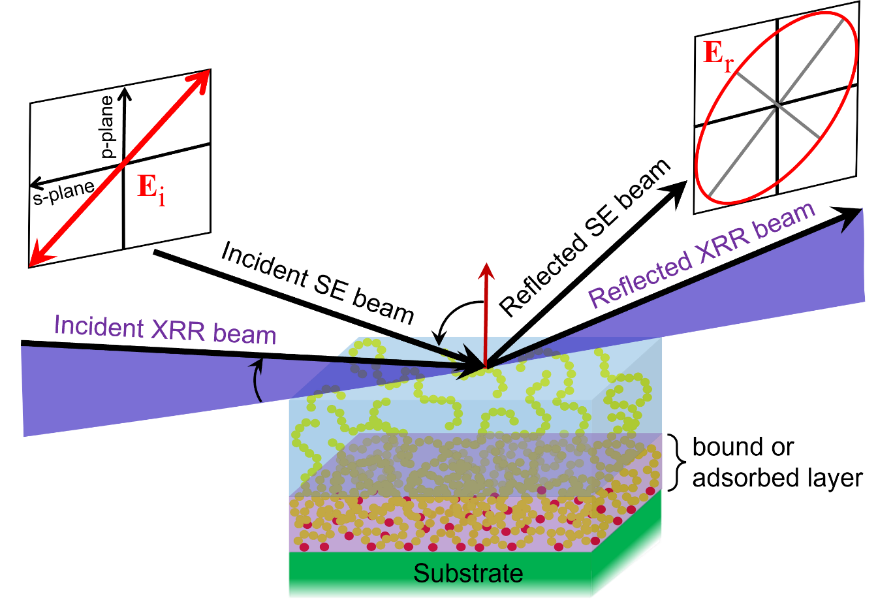
References:
- Determining the Characteristics of Ultrathin Polymer Films: A Spectroscopic Ellipsometry Approach SZ Bhutia, SK Sukumaran, DK Satapathy, Langmuir 40 (27), 14153-14165
- Probing the tightly bound layer in poly (vinyl alcohol) thin films using swelling measurements SZ Bhutia, L Pradipkanti, SK Sukumaran, DK Satapathy, Soft Matter 19, 3859-3870
- Stratification and two glass-like thermal transitions in aged polymer films L Pradipkanti, M Chowdhury, DK Satapathy, Physical Chemistry Chemical Physics 19 (43), 29263-29270
Self-assembly of colloidal systems
Self-assembly patterns are omnipresent in nature. Amongst all, evaporation driven self-assembly patterns are easy to probe for investigating the underlying mechanism of the pattern formation and can be utilized for various applications. When a colloidal dispersion drop dries in sessile mode, it generally produces thick ring like deposit, known as “Coffee ring”, which is not desirable for many applications. PNIPAM microgels, a great candidate of soft colloids, can suppress the coffee ring when either their aqueous dispersion is dried at a particular concentration or added to another dispersion of hard colloids acting like a surfactant. My work involves studying the pattern formation from drying aqueous drop of PNIPAM microgels and the corresponding evaporation dynamics by confining the drying drop between two substrates and altering the substrate temperature. Along with that, I study the dynamics of microgel aggregates or patches on a planar or curved interface. Confined drying mode produces monolayer deposits with unique reflection symmetry where the fraction of ordered to disordered areas can be tuned by varying the amount of confinement and particle concentration. Varying the substrate temperature can generates various patterns from inner deposit to coffee ring, uniform pattern to multiple-ring patterns. Interestingly, these microgel particles form circular patches at the air/water interface during evaporation and merge to form bigger patches which can give an idea about different scientific problems.

References:
- Soft colloidal monolayer with reflection symmetry through confined drying S Majumder, MG Basavaraj, DK Satapathy, Nanoscale Advances
- Depletion zone in two-dimensional deposits of soft microgel particles M Jose, R Singh, DK Satapathy, Journal of Colloid and Interface Science 642, 364-372
- Loosely Packed Monolayer Coffee Stains in Dried Drops of Soft Colloids M Mayarani, MG Basavaraj, DK Satapathy, Nanoscale
Soft actuators
Living organisms exhibit nastic and tropic movements in response to stimuli like light, temperature, humidity, and touch, showcasing their adaptability. Inspired by these natural processes, bio-inspired smart polymer-based materials are being explored for various applications including soft robotics. However, challenges like limited responsiveness, durability, and complex fabrication hinder their broader application. Among the various stimuli, vapour and light-responsive soft actuators stand out for their lightweight, high sensitivity, and fast response. We developed vapour responsive soft actuators based on the biopolymer such as silk, starch and gelatin. These vapour responsiveness actuation characteristics of these actuators extended to make multi-stimuli responsive soft actuators. In addition to multi-stimuli responsiveness, the direction and magnitude of the actuation is controlled by pattering and programming the applied stimuli. We also study the study the effect of physical and chemical modification of the polymer film on its actuation characteristics. These multi-functional actuators have potential applications in soft robotics, smart switches, biomimicry, smart lifts, voltage generation and vapour detection.
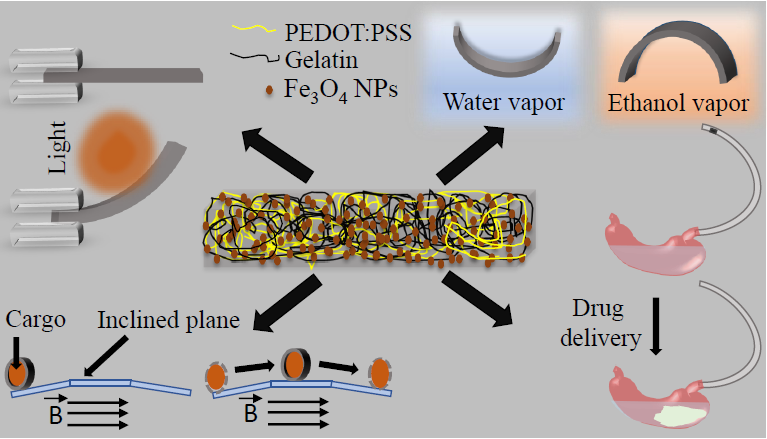
References:
- Multivapor-Responsive Controlled Actuation of Starch-Based Soft Actuators V Kumar, SA Siraj, DK Satapathy, ACS Applied Materials & Interfaces, 2024 16 (3), 3966–3977
- Vapor and Light Responsive Biocompatible Soft Actuator V Kumar, DK Satapathy, Langmuir, 2024, 40, 11206-11214
- Responsive Soft Actuator: Harnessing Multi-Vapor, Light, and Magnetic Field Stimuli V Kumar, DK Satapathy, Soft Matter 20 (27), 5435-5446
- Rapid Moisture-Responsive Silk Fibroin Actuators G Manikandan, A Murali, R Kumar, DK Satapathy, ACS Applied Materials & Interfaces 13 (7), 8880-8888
Flexible thermoelectric
Renewable thermoelectric (TE) technologies are receiving great attention these days because of their green energy harvesting, which does not emit any toxic gases to the environment. If these TE devices are flexible, then they can be used in wearable and implantable devices. Wearable TE devices can convert body heat into useful electric energy or vice-versa without having any parts. The conversion efficiency of these TE devices can be evaluated by a dimensionless figure of merit, ZT = S2σT/κ, where σ, S, κ, and T are the electrical conductivity, Seebeck coefficient, total thermal conductivity, and absolute temperature, respectively. The numerator term S2σ called the power factor, allows us to evaluate the performance of the TE materials. Conducting polymers (CPs) such as PEDOT: PSS, polyaniline (PANI), and polyethylene terephthalate (PET) and their composites are widely explored in the field of flexible TE applications. These CPs, when combined with inorganic materials, harness the advantage of TE properties of the inorganic while benefiting from the low thermal conductivity and flexibility inherent to CPs. In addition, non-conductive polymers like nylon and polyimide are also being investigated in the realm of flexible TE, where one deposits inorganic TE films on flexible substrates. Notably, ink printing has immense potential in the field of flexible TE because of its ease of processing, cost-effectiveness, and scalability. We work on fabricating high-performance flexible TE films using cost-effective and scalable methods on flexible polyimide/nylon substrates. Detailed insights into the remarkable thermoelectric properties of the flexible polymer-based films, along with illustrative proof-of-concept applications, are being investigated.
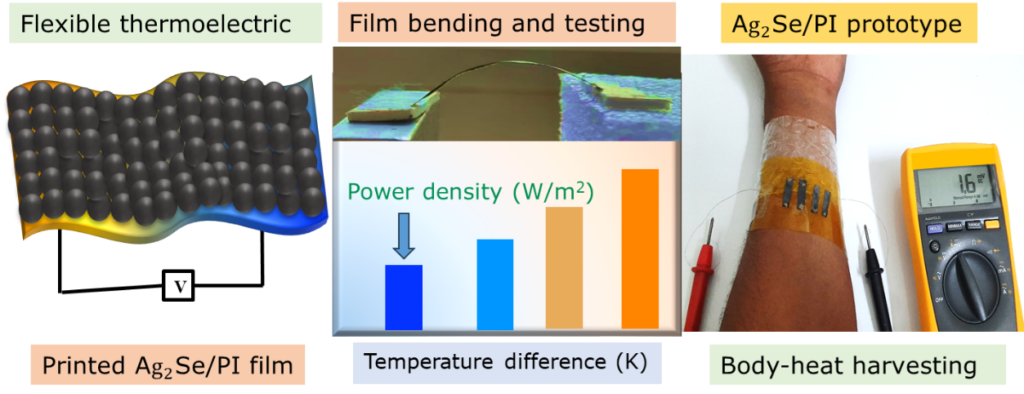
References:
- High-Performance Printed Ag2Se/PI Flexible Thermoelectric Film for Powering Wearable Electronics S Kumar, M Battabyal, K Sethupathi, DK Satapathy, ACS Applied Materials & Interfaces 16 (31), 40848-40857
- Realizing high phonon anharmonicity in layered : A temperature-dependent optical phonon study M Tiadi, DK Satapathy, M Battabyal, Physical Review B 109 (19), 195201
- Probing Thermoelectric Properties of Aluminium-Doped Copper Iodide TVV Ramana, M Battabyal, S Kumar, DK Satapathy, R Kumar, Physical Chemistry Chemical Physics
- Polymer-Infused Textile Thermoelectrics for Power Generation A Chauhan, S Kumar, DK Satapathy, M Battabyal, ACS Applied Electronic Materials 6 (4), 2774-2781
Self-assembly of polymer systems
Understanding the drying kinetics and resulting evaporative patterns of polymer-laden droplets on solid surfaces is crucial for applications in coating, printing, medical diagnostics, and microfluidics. A novel drying behaviour is observed when a polymer-laden aqueous drop evaporates on a high energy surface. The contact angle increases as the drop radius decreases, driven by polymer deposition at the contact line, leading to unconventional drying dynamics. The temporal increase in contact angle is observed to follow a power law scaling behaviour. This phenomenon produces diverse patterns influenced by polymer concentration and molecular weight, from central deposits to intricate fringe-like structures. Slowing down of evaporation rates transitions in evaporation-induced polymer growth from fibril to spherulitic in nature. Additionally, a hierarchical concentric ring polymer patterns with a precise control can be obtained through confined droplet evaporation, showing that bead separation significantly impacts the curvature and spacing of these rings.
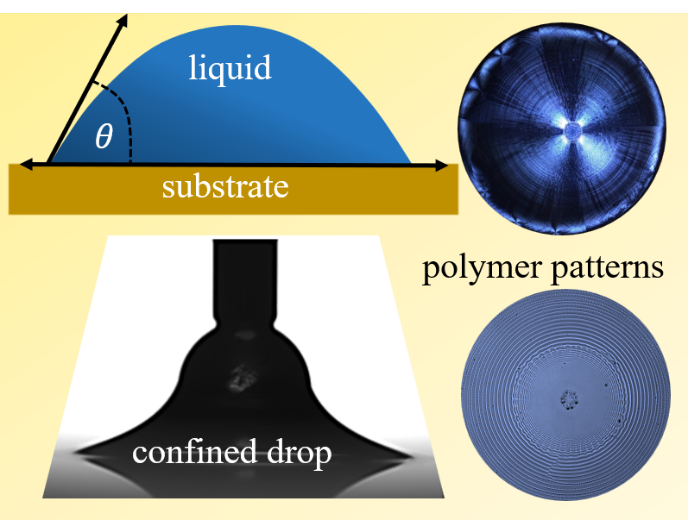
References:
Contact Angle Modulation: In Situ Polymer Deposition during Sessile Drop Evaporation S Gupta, SN Varanakkottu, E Mani, DK Satapathy, Langmuir, 2024
